Content for TS 23.216 Word version: 18.0.0
7 Charging
8 Handover Failure
8.1 Failure in EUTRAN/UTRAN (HSPA) to 3GPP UTRAN/GERAN (v)SRVCC
8.2 Failure in CS to PS SRVCC
8.3 Failure in 5G-SRVCC from NG-RAN to 3GPP UTRAN
9 Security
9.1 Network Domain Security with 3GPP2 1xCS IWS
9.2 Network Domain Security with 3GPP UTRAN/GERAN MSC Server
7 Charging p. 67
See clause 8 of TS 23.292 on charging for guidance on the handling of charging for SRVCC.
8 Handover Failure p. 67
8.1 Failure in EUTRAN/UTRAN (HSPA) to 3GPP UTRAN/GERAN (v)SRVCC p. 67
8.1.1 Failure before MSC Server initiates Session Transfer p. 67
If a failure is encountered before the MSC Server initiates Session Transfer, then the standardised handover failure procedures apply according to TS 23.401. No further action is required by the UE.
8.1.1a Failure after MSC Server initiates Session Transfer |R10| p. 67
8.1.1a.1 Failure before responding to PS to CS HO request p. 67
If the MSC Server receives a negative response from IMS during the Session Transfer procedure (e.g., due to invalid STN-SR, or temporary failure, etc) and the MSC Server has not yet responded back to MME/SGSN with a positive PS to CS Response message due to successful target CS radio resource reservation, then MSC Server shall reject this PS To CS Request with a Reject cause pointing to either permanent or temporary "Session Transfer leg establishment error" and MSC Server shall release the CS radio resource at the target RAT.
When MME/SGSN receives the PS to CS Response with a reject cause related to "permanent Session Transfer leg establishment error", MME/SGSN may take that indication into account to prevent further SRVCC handover attempts.
The following Figure 8.1.1a-1 shows the overall procedure when the MSC Server aware of the Session Transfer failure prior to responding to PS to CS HO request.
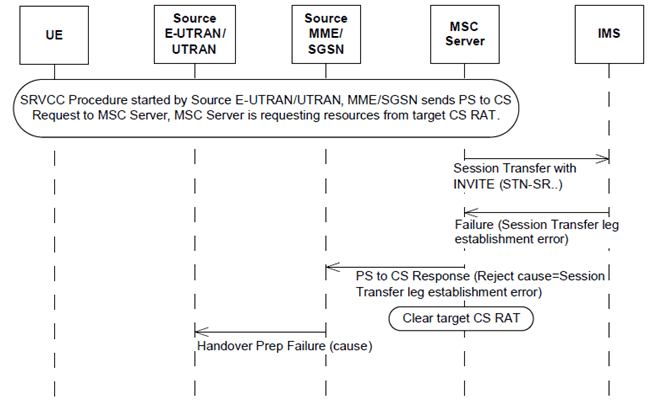
Figure 8.1.1a-1: SRVCC Handover Rejection due to Session Transfer leg establishment error before responding to PS to CS HO request
(⇒ copy of original 3GPP image)
(⇒ copy of original 3GPP image)
8.1.1a.2 Failure after responding to PS to CS HO request p. 68
If the MSC Server receives a negative response from IMS during the initiates Session Transfer procedure (e.g. due to invalid STN-SR, or temporary failure, etc) and the MSC Server has already responded back to MME/SGSN with a positive PS to CS Response message due to successful target CS radio resource reservation and has not yet sent PS to CS Complete Notification, then MSC Server shall indicate to MME/SGSN with an error cause pointing to either permanent or temporary "Session Transfer leg establishment error" in PS to CS complete notification message, MME/SGSN shall perform the bearer release procedure as according to the normal SRVCC procedure as defined in clauses 6.2 and 6.3.
When MME/SGSN receives this PS to CS Complete notification message with an error cause pointing to "permanent Session Transfer leg establishment error", MME/SGSN may take that indication into account to prevent further SRVCC handover attempts.
The following Figure 8.1.1a-2 shows the overall procedure when the MSC Server aware of the Session Transfer failure after the PS to CS HO request has been responded to MME/SGSN.
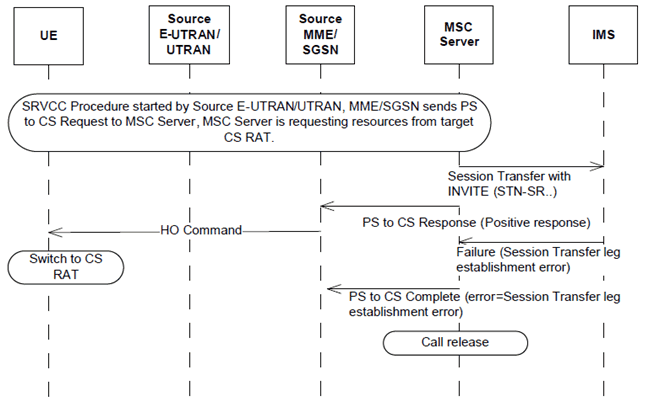
Figure 8.1.1a-2: SRVCC Handover Rejection due to Session Transfer leg establishment error after responding to PS to CS HO request
(⇒ copy of original 3GPP image)
(⇒ copy of original 3GPP image)
8.1.2 Failure after UE receives HO command p. 69
If the UE encounters a failure at the radio level after it receives the handover command and does not successfully transition to 3GPP UTRAN/GERAN RAT, the UE attempts to return to E-UTRAN/UTRAN by sending a re-INVITE to the SCC AS. The core network (MME, MSC Server) shall take no (v)SRVCC specific action in the event of not receiving the Handover Complete message from the UE.
8.1.3 Handover Cancellation p. 69
If the source E-UTRAN/UTRAN decides to terminate the handover procedure before its completion, the MME/SGSN shall return to its state before the handover procedure was triggered. The MME/SGSN attempts to trigger, at the MSC Server enhanced for SRVCC, handover cancellation procedures according to TS 23.009.
The MME/SGSN shall also send a session reestablishment trigger notification to UE to start the recovery procedure if it receives notification from the MSC Server that the Session Transfer procedure is in progress.
The source E-UTRAN/UTRAN shall not attempt any new SRVCC procedures until the cancellation has successfully been completed and source E-UTRAN/UTRAN have received an acknowledgment of the previous HO cancellation. If MSC has already triggered session transfer, then the UE needs to be provided with a Session Reestablishment trigger before a new cancellation attempt.
Figure 8.1.3-1 shows the overall procedure for SRVCC handover cancellation.
For vSRVCC the MME and MSC also behave the same way as in the case of SRVCC handover cancellation.
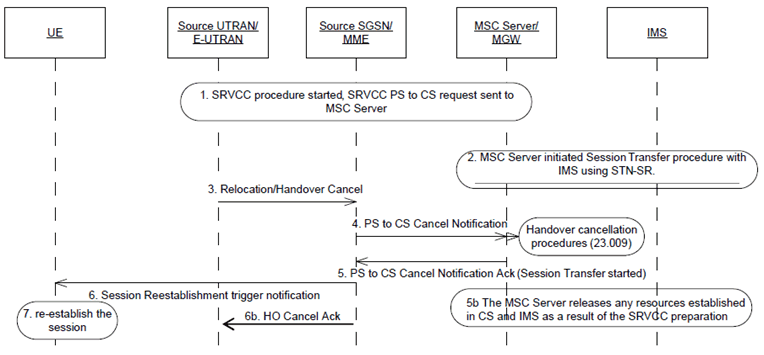
Step 1.
Network has started the SRVCC procedure. SGSN/MME has sent the SRVCC PS to CS request to MSC Server.
Step 2.
MSC Server is performing the CS HO procedure with target network, and has also started the Session Transfer procedure with IMS with STN-SR, see TS 23.237.
Step 3.
Source UTRAN/E-UTRAN decides to cancel the SRVCC HO Procedure by sending a Cancel message to SGSN/MME.
Step 4.
Source SGSN/MME indicates SRVCC PS to CS Cancel Notification to MSC Server to start the HO cancellation procedure as according to TS 23.009.
Step 5.
MSC Server acks the PS to CS Cancel Notification with an indication that Session Transfer procedure is in progress.
Step 5b.
The MSC Server releases any resources established in CS and IMS as a result of the SRVCC preparation.
Step 6.
Due to the Session Transfer procedure in progress indication, the source SGSN/MME sends a Session Reestablishment trigger notification to UE to start the session re-establishment procedure
Step 6b.
The source SGSN/MME confirms the Cancel message provided in step 3.
Step 7.
UE starts the re-establishment procedure, by attempting to return to E-UTRAN/UTRAN by sending a re-INVITE towards IMS for the related session. If the session is no longer active, then this session transfer request shall be rejected by the IMS.
8.1.4 Handover Failure due to alerting/pre-alerting state |R15| p. 70
If either an UE, MSC server, or IMS (e.g. SCC AS, EATF, or ATCF) does not support the required alerting or pre-alerting SRVCC capabilities as defined in TS 23.237 then handover failure scenario as defined in clause 8.1.1a is followed with the following additional clarifications:
- At the session transfer request from MSC server with E-STN-SR or STN-SR, IMS returns a temporary failure indication to this request.
- MSC Server, if supported, shall be configured to not return a PS-CS Response to source MME/SGSN until it receives either a positive or negative indication with temporary failure from IMS, or due to other normal error handling (e.g., timeout).
8.2 Failure in CS to PS SRVCC |R11| p. 71
8.2.1 Failure before UE initiates Session Transfer detected by MSC Server p. 71
Figure 8.2.1-1 provides the procedures of how the MSC server handles errors when HO Required is received.
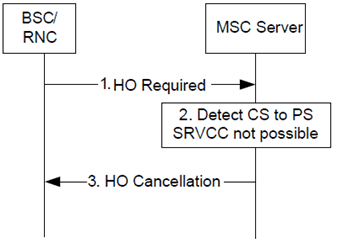
Step 1.
If the HO cancellation is done prior that the Session Transfer Preparation request, but after the Session Transfer Notification, the MSC Server shall send a notification session transfer cancellation to IMS to indicate that the transfer has been cancelled to allow IMS to de-allocate any resources it may have reserved.
The RNC/BSC sends a HO required to the MSC Server including an indication this HO is for CS to PS SRVCC.
Step 2.
The MSC Server checks if CS to PS HO is possible, e.g., that the UE is still registered in IMS. In this flow, the MSC Server detects that CS to PS SRVCC cannot be performed.
Step 3.
MSC Server cancels the HO with a specific cause that the RNC/BSC will not perform further HO attempts for CS to PS SRVCC.
8.2.2 Failure before UE initiates Session Transfer detected by MME p. 71
Figure 8.2.2-1 provides the procedures of how the MSC server handles errors when HO Required is received.
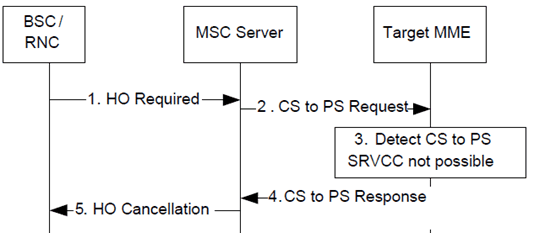
Step 1.
The cancellation is done prior that the Session Transfer Preparation request, but after the Session Transfer Notification, the MSC Server shall send a notification session transfer cancellation to IMS to indicate that the transfer has been cancelled to allow IMS to de-allocate any resources it may have reserved.
The RNC/BSC sends a HO required to the MSC Server including an indication this HO is for CS to PS. If the MSC Server is the target MSC, it forwards the HO required to the anchor MSC Server.
Step 2.
The MSC Server sends a SRVCC CS to PS Request to the Target MME. If required, the IMSI is provided for identifying the UE, and the P-TMSI and RAI is provided to MME if available.
Step 3.
The MME has no UE context and tries to find the source SGSN/MME. For some reason, the UE context cannot be found. The MME cancels the HO.
Step 4.
The MME sends SRVCC CS to PS Response, with cause indicating failure, to the MSC Server.
Step 5.
MSC Server cancels the HO with a specific cause that the RNC/BSC will not perform further HO attempts for CS to PS SRVCC.
8.2.3 CS to PS Handover Cancellation p. 72
If the source RAN decides to terminate the handover procedure before its completion, the MSC Server shall start the Cancellation procedure if it has initiated the CS to PS HO command towards the MME. Figure 8.2.3-1 shows the overall procedure for SRVCC CS to PS handover cancellation.
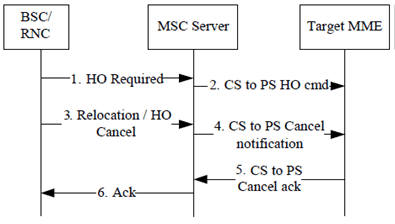
Step 1-2.
If the HO cancellation is done prior that the Session Transfer Preparation request, but after the Session Transfer Notification, the MSC Server shall send a Session Transfer Notification cancellation to IMS to indicate that the transfer has been cancelled to allow IMS to de-allocate any resources it may have reserved.
Network has started the SRVCC CS to PS procedure. MSC Server has sent the SRVCC CS to PS request to MME. MME is performing the SRVCC CS to PS HO procedure with target network.
Step 3.
Source RAN decides to cancel the SRVCC CS to PS HO Procedure by sending a Cancel message to MSC Server.
Step 4.
Source MSC Server indicates SRVCC CS to PS Cancel Notification to MME to start the HO cancellation procedure.
Step 5.
MME acks the CS to PS Cancel Notification.
Step 6.
The MSC Server acknowledges the HO Cancelation from BSC/RNC and resumes the CS session.
8.3 Failure in 5G-SRVCC from NG-RAN to 3GPP UTRAN |R17| p. 73
Such failures are handled as defined for Failure in EUTRAN/UTRAN (HSPA) to 3GPP UTRAN/GERAN (v)SRVCC in clause 8.1 with following modifications:
- When as defined in clause 8.1.1a.1 the MSC Server rejects a PS To CS Request with a Reject cause pointing to either permanent or temporary "Session Transfer leg establishment error", the MME-SRVCC shall transfer this information to the AMF. The AMF indicates to the NG RAN the Handover preparation failure. The AMF may take an indication of "permanent Session Transfer leg establishment error" into account to prevent further SRVCC handover attempts.
- When as defined in clause 8.1.1a.2, the MSC Server indicates an error cause pointing to either permanent or temporary "Session Transfer leg establishment error" in PS to CS complete notification message, the AMF based on the absence of a Forward Relocation Complete Notification determines the failure of the SRVCC procedure.
- When as defined in clause 8.1.2, there is a Failure after UE receives HO command, the UE attempts to return to NG RAN the core network (AMF, MME-SRVCC, MSC Server) shall take no (v)SRVCC specific action in the event of not receiving the Handover Complete message from the UE.
- When as defined in clause 8.1.3, the source RAN (NG RAN) decides to terminate the handover procedure before its completion, the AMF shall attempt to have the MME-SRVCC trigger, at the MSC Server enhanced for SRVCC, handover cancellation procedures. The AMF shall also send a session reestablishment trigger notification to UE to start the recovery procedure if it received a notification that the Session Transfer procedure is in progress.
- Same requirements as defined in clause 8.1.4, for Handover Failure due to alerting/pre-alerting state.
9 Security p. 73
9.1 Network Domain Security with 3GPP2 1xCS IWS p. 73
Network domain security with 3GPP2 1xCS IWS shall be provided by NDS/IP according to TS 33.210 with integrity protection and confidentiality. This shall be applied whenever signalling messages (e.g. containing security context) are transferred on the S102 reference point.
9.2 Network Domain Security with 3GPP UTRAN/GERAN MSC Server p. 73
Network domain security with 3GPP UTRAN/GERAN MSC Server shall be provided by NDS/IP according to TS 33.210 with integrity protection and confidentiality. This shall be applied whenever signalling messages (e.g. containing security context) are transferred on the Sv reference point.